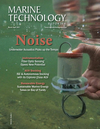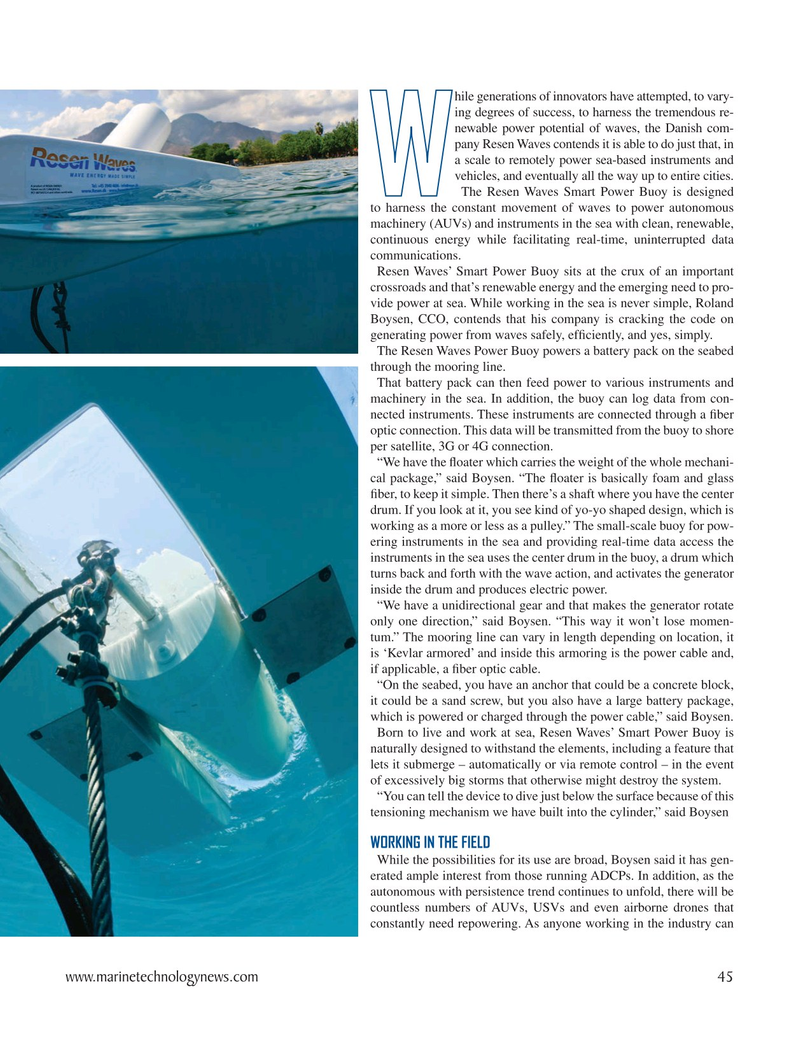
Page 45: of Marine Technology Magazine (March 2021)
Oceanographic Instrumentation & Sensors
Read this page in Pdf, Flash or Html5 edition of March 2021 Marine Technology Magazine
hile generations of innovators have attempted, to vary- ing degrees of success, to harness the tremendous re- newable power potential of waves, the Danish com- pany Resen Waves contends it is able to do just that, in a scale to remotely power sea-based instruments and vehicles, and eventually all the way up to entire cities.
The Resen Waves Smart Power Buoy is designed to harness the constant movement of waves to power autonomous machinery (AUVs) and instruments in the sea with clean, renewable, continuous energy while facilitating real-time, uninterrupted data communications.
Resen Waves’ Smart Power Buoy sits at the crux of an important crossroads and that’s renewable energy and the emerging need to pro- vide power at sea. While working in the sea is never simple, Roland
Boysen, CCO, contends that his company is cracking the code on generating power from waves safely, ef? ciently, and yes, simply.
The Resen Waves Power Buoy powers a battery pack on the seabed through the mooring line.
That battery pack can then feed power to various instruments and machinery in the sea. In addition, the buoy can log data from con- nected instruments. These instruments are connected through a ? ber optic connection. This data will be transmitted from the buoy to shore per satellite, 3G or 4G connection.
“We have the ? oater which carries the weight of the whole mechani- cal package,” said Boysen. “The ? oater is basically foam and glass ? ber, to keep it simple. Then there’s a shaft where you have the center drum. If you look at it, you see kind of yo-yo shaped design, which is working as a more or less as a pulley.” The small-scale buoy for pow- ering instruments in the sea and providing real-time data access the instruments in the sea uses the center drum in the buoy, a drum which turns back and forth with the wave action, and activates the generator inside the drum and produces electric power.
“We have a unidirectional gear and that makes the generator rotate only one direction,” said Boysen. “This way it won’t lose momen- tum.” The mooring line can vary in length depending on location, it is ‘Kevlar armored’ and inside this armoring is the power cable and, if applicable, a ? ber optic cable. “On the seabed, you have an anchor that could be a concrete block, it could be a sand screw, but you also have a large battery package, which is powered or charged through the power cable,” said Boysen.
Born to live and work at sea, Resen Waves’ Smart Power Buoy is naturally designed to withstand the elements, including a feature that lets it submerge – automatically or via remote control – in the event of excessively big storms that otherwise might destroy the system.
“You can tell the device to dive just below the surface because of this tensioning mechanism we have built into the cylinder,” said Boysen
WORKING IN THE FIELD
While the possibilities for its use are broad, Boysen said it has gen- erated ample interest from those running ADCPs. In addition, as the autonomous with persistence trend continues to unfold, there will be countless numbers of AUVs, USVs and even airborne drones that constantly need repowering. As anyone working in the industry can www.marinetechnologynews.com 45
MTR #3 (34-49).indd 45 3/22/2021 9:24:24 PM

 44
44

 46
46
